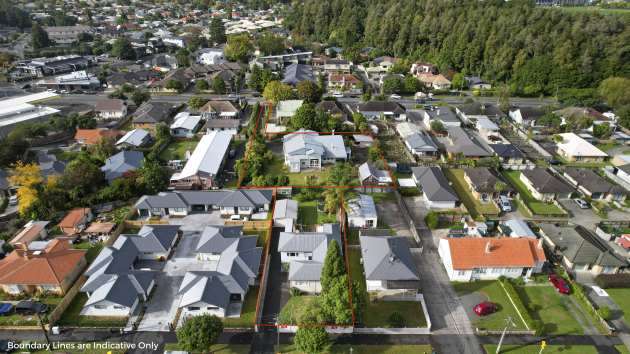Larger residential sections that were last year selling like hot cakes to land-bankers and developers are now one of the hardest types of properties to sell.
Real estate agents in Auckland and Hamilton told OneRoof demand for properties with development potential had dried up.
Hamilton-based Lodge agent Blair Pointon said some developers were unable to move on from their current projects, with building delays slowing them down.
Pointon said: “Usually, I would sell a whole development before it’s complete, whereas now they are getting nearing completion and have still got them all available so they can’t move as quickly on other developments. And obviously the price is going back so that doesn’t help.”
Start your property search
He is currently marketing two neighbouring properties in Claudelands, Hamilton, which have a combined foot print of 2133sqm. The offering is aimed at developers and landbankers and has been priced at $2.299 million after failing to sell at tender.

137 Boundary Road and 70 Claude Street, in Claudelands, Hamilton, are priced at $2.299m. Photo / Supplied
It’s a stark contrast to a modest three-bedroom bungalow Pointon sold under the hammer last March on nearby Young Street for $1.016m - 120% more than its $460,000 rateable value.
Pointon told the New Zealand Herald at the time that he expected it to sell for around $800,000 due to the uncertainty over whether the 892sqm section was large enough to build two duplexes on.
Harcourts Glenfield agent David Ding said larger sections with older homes were the hardest properties to sell at the moment because their main target market - developers, investors and land-bankers – were not buying due to the tough lending rules.
Ding currently has three of older houses on 650sqm sub-dividable sections listed for sale in central North Shore and they have all been on the market for at least three months.
“Last year those were hot potatoes – what I mean by hot potatoes is three weeks guaranteed sold. This year the only kind of property I cannot get sold is this type of property.”
Ding said these properties would still make good first homes, but the price would have to drop by about 20%. “The first-home buyer isn’t going to pay anywhere near what the developer would pay.”

Auckland agent David Ding says the development market had cooled since last year. Photo / Fiona Goodall
A developer could subdivide a 650sqm section into four, whereas for a first-home buyer that size section just meant their dog or children might have a bit more room to play, he said.
“If they want to sell now they have two options – a) they hold it until the developer comes back ... or they have to meet the market which is the first home market.”
Ding said these types of properties were still on the market not because people had changed their minds about developing them, but because they might be leaving Auckland, getting divorced or moving into a retirement village.
Ray White Papakura agent Anthony Russell said properties with larger land sizes in Papakura had not been getting much traction since November last year because developers were not buying.
“The problem with so many developers is they hadn’t completed the projects they already had – they couldn’t get labour, materials, supplies, shipping and cost of the product was much higher and the shipping wasn’t on time anyway.”

Valocity head of valuations James Wilson rising interest rates have added to developer woes. Photo / Fiona Goodall
Valocity head of valuations James Wilson said larger sites in Auckland and other main urban centres such as Hamilton which had been selling like “hot cakes” last year due to their development potential now appeared to be proving too hard for some.
It was a stark contrast to the huge demand for them 12 to 18 months ago, he said.
“What we are hearing and beginning to see in those types of properties is that people that snapped them up are now realising that the cost to do that - so the vision or the build - has gone up, but also so has the timeline to do them.”
They had instead decided to cut their losses and resell them because they were no longer going to achieve their original returns, especially due to a number of factors including the building delays and costs, rising interest rates and longer holding time, he added.









































































